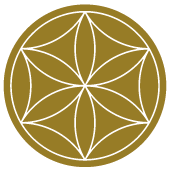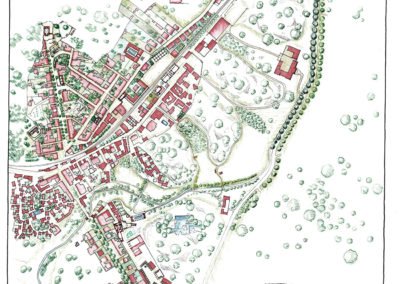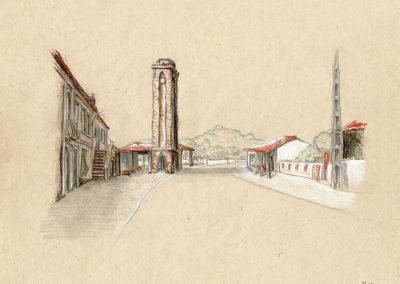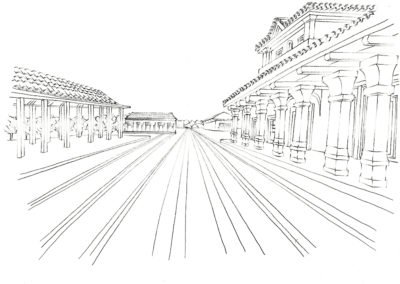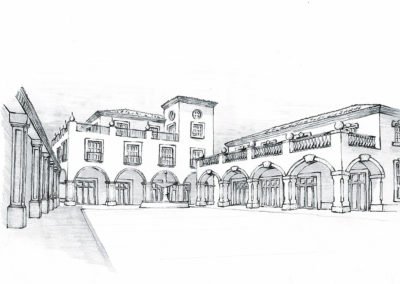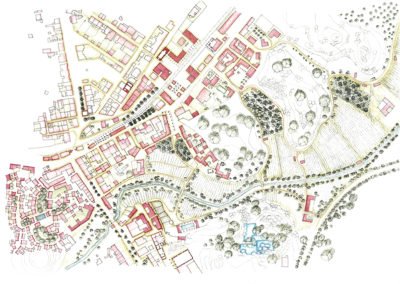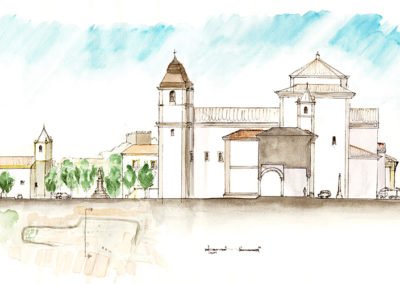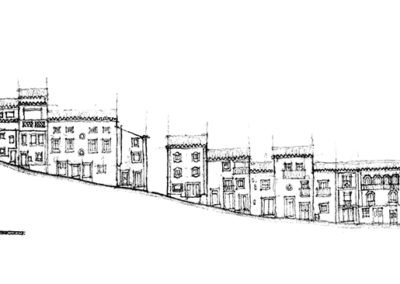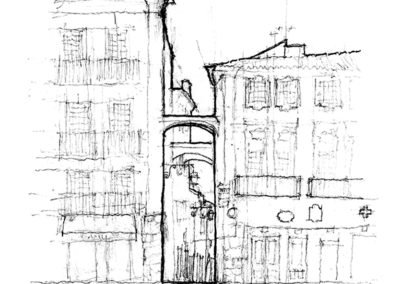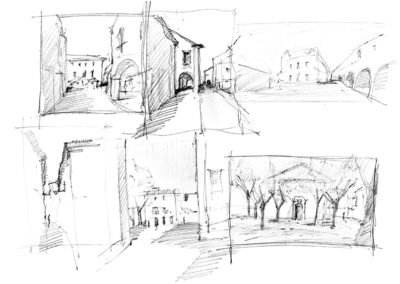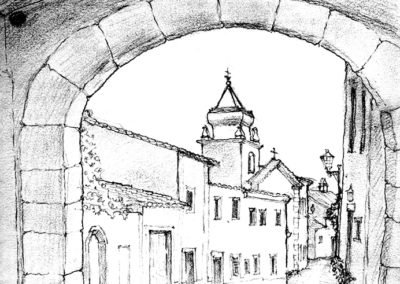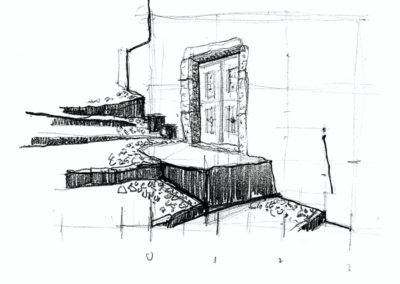Marvão Traditional Architecture Summer Shool 2018

The area of Beirã, belonging to the municipality of Marvão, hosted during the last two weeks of July 2018, the 5th Traditional Architecture and Urbanism Summer School. There, teachers and students coming from all over the world studied the traditional construction, architecture and urbanism of the region and took them as the basis to develop different design proposals for the future development of this place.
Presentation
The participants, from different backgrounds, ages and profiles were the following: Mary-John Blevins, Deyglis Castillo, Laura Celeste Beltrán, Elizabeth Connaughton, Inti Carina Dohle, Luis García-Delgado Ripoll, Chesney Henry, Iria Ibáñez Vilar, Molly Jorden, Rachael Liberman, Saniya Malhotra, Margarida Alexandra Matos Bessa, Andrew Moneyheffer, Miguel Torres Monteiro Afonso, Pedro Paulo Palazzo, Llorenç Pons, Emilio Roldán Zamarrón, Nadia Samir, João Pedro Salvado, Julia Marie M. de Santos, Alexandra Scupin, Vikramaditya Singh Rathore, Natalie Stenger, Alexis Stypa, Alissa Tassopoulos, Mario Vides, Arnost Wallach y Vasco Wemans. The nationalities which were present in this group prove this large diversity; Germany, Brazil, Spain, the U.S., the Philippines, Guatemala, India, Mexico, Portugal, the U.K., the Czech Republic, Romania and Venezuela.
The team of teachers consisted of a set of both professionals and academics dedicated to this area of study also in several countries: José Baganha (INTBAU Portugal), Douglas Duany (University of Notre Dame), Ruth M. Equipaje (Pontifical and Royal University of Santo Tomas – INTBAU Philippines), Rui Florentino (Escola Superior Gallaecia – INTBAU Portugal), Frank Martínez (University of Miami), Christopher C. Miller (Judson University), y Alejandro García Hermida (Universidad Alfonso X el Sabio – INTBAU Spain ), coordinator and organiser of the Summer School, with the collaboration of Rebeca Gómez-Gordo Villa (INTBAU Spain). We must also mention those who acted as guest lecturers, which were: Mónica Alcindor (Escola Superior Gallaecia), Fernando Aranda Egido (Kalam), Inês Cabral (Universität Leipzig – Escola Superior Gallaecia), Aurora Carapinha (CHAIA – Universidade de Évora), Joaquim Carvalho (Fundação Cidade de Ammaia), Francisco Javier Castilla Pascual (Universidad de Castilla-La Mancha), Francisco Adão da Fonseca (Fundação Serra Henriques), Alexandre Castro Gamelas and Catarina Santos (INTBAU Portugal), Maria Filomena Gaspar Picado (Beirã), Leopoldo Gil Cornet (Universidad de Navarra – INTBAU Spain), Kim Hitch (Prince’s Foundation), Jaime de Hoz (Universidad Alfonso X El Sabio – CIAT-UPM), Ana Lima (Escola Superior Gallaecia), Rafael Manzano Martos (INTBAU Spain), Manuel Montañés García (Kalam), José Luís Possolo de Saldanha (ISCTE – Instituto Universitário de Lisboa), Miguel Reimão Costa (Universidade do Algarve), Harriet Wennberg (INTBAU) and Carol Wyant (Project Manager of the Rafael Manzano Prize).
Apart from the aforementioned, there are a lot of people who we have to thank for their collaboration. Their work has really enabled this Summer School to take place. Because of their commitment and support it was key to have José Baganha, Rita Pinto Coelho, Alexandre Resende, Edmundo Silva, Luís Vitorino, Victor Frutuoso, António Borges, António Mimosa, Eduardo Salvador, Lina Paz, Américo Sêco and Rui Florentino in our first visits to Beirã and the preparatory arrangements before the Summer School itself even started, but it was also key to have (during the actual development of the Summer School), the collaboration of the team belonging to the A Anta Association: Ana Paula Sêco, Ana Bela Felício, Catarina Serra, Isabel Silva, Marisa Nunes, Cristina Videira, Fatima Viegas, Ludovina Raposo, and in general the whole of the population in Beirã, who really made the entire team feel at home from the very beginning.
the Summer School program was structured in two different stages. The first one, developed during the first week, had its focus on learning about the place, its landscape, its territory, its history, its culture and heritage and its current situation. The time was mostly dedicated to travel around, studying and analysing those places we visited, and using just the evenings, to avoid interrupting the intense daily work, for getting lectures by local experts on all the aforementioned topics. The second one, corresponding to the second week, was mainly used to apply everything learned during the previous days to the new designs to be proposed.
We visited the fortified town of Marvão, the Roman site of Ammaia, the beautiful and lively town of Castelo de Vide, guided by José Luis Saldanha, the main town of the region, Évora, with the guidance of Aurora Carapinha, as well as Elvas, Estremoz, Terena and Alandroal. The aim to understand and apprehend the diverse types of public spaces and urban fabrics existing in these towns, their response to topography, climate and their diverse functions, as well as the different features defining their qualities. Section elevations, plans and views, as well as studies of particular details, were drawn on site on each of them.
These visits were complemented by the many guest lectures already referred, all of them dealing with the Alentejo region, its history, its landscape and its architecture first, and then, in the second week, presenting diverse works which using tradition as a base for contemporary design, might inspire the design challenge being undertaken. There were also several demonstrations on traditional building crafts, such as lime washing and sgraffitto techniques, highlighting the link of the continuity of traditional architecture and that of the crafts supporting it.
Based on all the previously developed study on the building, architecture and urbanism of the Alentejo, we started facing the already explained design challenges Infraestructuras de Portugal (Portuguese Infrastructures), the Municipality of Marvão and the Freguesia de Beirã proposed us to address.
We divided the town in five different areas in order to work in different groups on each one of them in more detail: Centro, Mercado, Ribeira, Bairro Alto and Arrabalde. Centro is the former central area of the town, still hosting the most spatially defined urban spaces, but with a currently unsuccessful connection with the neighbouring railway area. Our Mercado, or Market, area was the former town hub around the train station and its main facilities, intending with its very name to highlight its main function was and could be again, under a new shape and intent, commercial. The Bairro Alto, or Upper Town, is formed by the streets climbing the northern heights from the old town, nowadays topped by the public washing facilities. The Ribeira, or Riverside, is the area currently separating the old town and the railway facilities from the most recent extensions of the town, and it is partly occupied by orchards which should remain in this advantageous location. Nevertheless, infill is needed also here to generate a consistent urban fabric. Finally, the Arrabalde, or Outskirts, is the newest part of Beirã, developed along the road heading to Santo António das Areias and Marvão, and needing to be reconnected to the rest of the town. Apart from it, a member of each group was designated to coordinate with the other groups. These representatives met to coordinate the edges of the neighborhoods and the diverse connections among them.
The aim: to produce a comprehensive design for the possible future development of the town, allowing it to change in a successful, beautiful and socially integrating way, but also in a respectful manner to local culture.
The former station, thanks to Infrastructures of Portugal, came back to life during those two weeks, turned into a classroom first, full of boards and drawing tools, and in an exhibition hall later, welcoming a good representation of the local population, which so warm and kindly hosted us during those days, and joined us, to our joy, for the final public presentation of the work done. The conferences and debates that accompanied this work were hold in the building that formerly housed its restaurant and today houses the Train Spot Hotel. This work from the early twentieth century by the fantastic Portuguese architect Raul Lino, was itself a perfect model to inspire our work.
Publication: A project for the future of Beirã, based on the traditional architecture and urbanism of the Alentejo region
This publication, by the Fundação Serra Henriques, presents the results of the Marvão Traditional Architecture Summer School, which was organized by INTBAU and by the Rafael Manzano Prize for New Traditional Architecture. It was possible thanks to the support provided by the Richard H. Driehaus Charitable Lead Trust (through a contribution to the Chicago Community Foundation for the Richard H. Driehaus Charitable Fund), the Fundação Serra Henriques and Kalam. Equally important was the collaboration of the Câmara Municipal de Marvão, the Junta de Freguesia de Beirã, the A Anta Association, also from Beirã, and the Infrastructures of Portugal, as well as the Escola Superior Gallaecia, the Instituto Universitário de Lisboa (ISCTE-IUL), the Universidade do Algarve and the Universidade de Évora (Portugal), the Pontifical and Royal University of Santo Tomas (Philippines), the Schools of Architecture of the Judson University, the University of Miami and the University of Notre Dame (USA), the Universidad Alfonso X el Sabio, the Universidad de Castilla-La Mancha and the Universidad Politécnica de Madrid (Spain) and the Centro de Investigación de Arquitectura Tradicional (CIAT-UPM).
Program
Download here the Marvão Traditional Architecture Summer School 2018 Program



